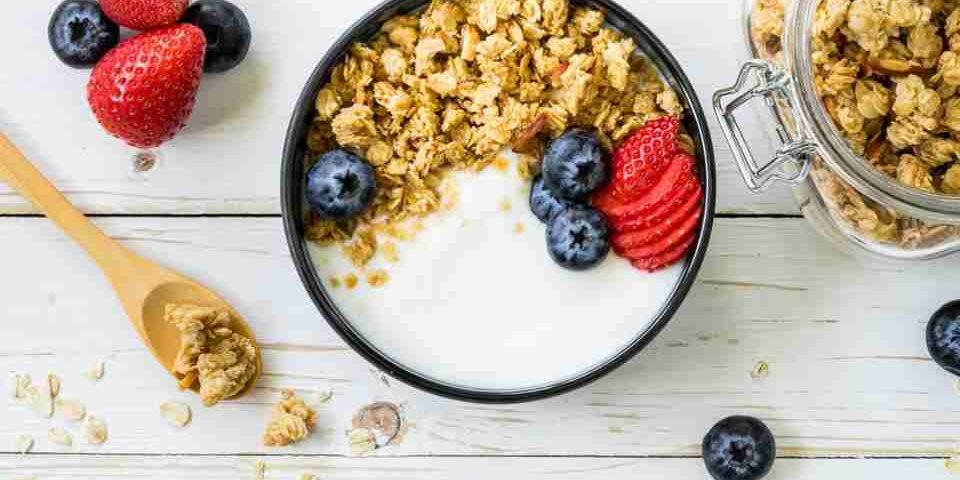- 如有疑问,请联系电邮
- customer@ihealth66.com
USNEWS:希腊酸奶与普通酸奶:哪一种更健康?

雪松-西奈医学中心(Cedars-Sinai Medical Center, Los Angeles, Calif.)
2018年12月19日
最新临床试验:奥比妥珠单抗联合或不联合乌姆拉西布、来那度胺或联合化疗治疗复发或难治性I-IIIa级滤泡性淋巴瘤
2018年12月20日By Ruben Castaneda and Angela Haupt
希腊式酸奶与传统的对手和其他选择相比有什么不同?今天两位健康专栏作家专注了这个问题。希腊式酸奶比传统酸奶含糖量低,蛋白质含量提高,被众多营养学家推荐,是非常好的健康食品。而从价格上也可以看出来,超市里相同量的酸奶,希腊式酸奶要比普通酸奶贵一倍。因此,你应该明白自己应该如何选择了!
NOT LONG AGO, GREEK yogurt was considered an exotic option. Today, it’s as ubiquitous as regular dairy yogurt. Most consumers give a big thumbs-up to its taste – tangier, less sweet and creamier than conventional “regular” yogurt made from whole milk. But is Greek yogurt healthier than its conventional counterpart? And what about the wide array of other types of yogurts?
First, to be clear: Greek and regular yogurt, in their plain, nonfat or low-fat forms, as well as the wide variety of plant-based and premium yogurts, can be part of a healthful diet. They’re low in calories and packed with calcium and live bacterial cultures. But our Mediterranean friend – which is strained extensively to remove much of the liquid whey, lactose and sugar, giving it its thick consistency – does have an undeniable edge. In roughly the same amount of calories, it can pack up to double the protein, while cutting sugar content by half. Those are “two things dietitians love,” says Dawn Jackson Blatner, a registered dietitian and author of “The Flexitarian Diet.” “For someone who wants the creamier texture, a little bit of a protein edge and a sugar decrease, going Greek is definitely not all hype.”
Sharon P. Banta, a registered dietitian based in Brooklyn, New York, agrees. “Greek yogurt is better than regular yogurt because it’s higher in protein,” Banta says. “I suggest plain low-fat Greek yogurt to my patients as a low-fat, nutrient-rich option.” In the last decade or so, Greek yogurt sales nationwide have surged, likely because the product satisfies consumers’ needs for health, convenience and taste, according to Nielsen, a global marketing and advertising research company. As of 2016, Greek yogurt sales accounted for 52 percent of the total U.S. yogurt market, according to Statista, a market and consumer data firm.
In addition to Greek and regular yogurt, an array of other yogurts are now on the market, says Jenna Bell, a registered dietitian based in St. Petersburg, Florida. She’s the co-author of the book “Energy to Burn: The Ultimate Food and Nutrition Guide to Fuel Your Active Lifestyle.” Among the many yogurt options are non-dairy yogurt, non-dairy Greek yogurt, low-fat yogurt, nonfat yogurt, high-protein yogurt and sugar-free yogurt.
Here’s a closer look at how Greek and regular yogurt stack up nutrition-wise.
Protein. Greek yogurt is high in protein, which helps promote fullness. A typical 6-ounce serving contains 15 to 20 grams, the amount in 2 to 3 ounces of lean meat. That makes it particularly appealing to vegetarians, who sometimes struggle to get enough of the nutrient. An identical serving of regular yogurt, on the other hand, provides just 9 grams, meaning you may feel hunger pangs sooner. “Getting an adequate amount of protein daily is important for your immune system, fluid balance and your nerves,” says Ann Louise Gittleman, a certified nutrition specialist based in Post Falls, Idaho. She’s the author of “Radical Metabolism: A Powerful New Plan to Blast Fat and Reignite Your Energy in Just 21 Days.” The protein in Greek yogurt is high in quality, Bell says. If you want an alternative that’s full of high-quality protein, you might consider soy-based yogurts, she advises. “They have around 9 grams of protein per serving,” Bell says. “But plant proteins other than soy do not have all of the essential amino acids to make it a complete protein. For example, most nuts are low in a couple of essential amino acids and are considered incomplete proteins.” That’s not a big deal, because usually can make up for the limited amino acids in plant protein with other foods, like whole-grain breads, beans and legumes.
Carbohydrates. Going Greek is a smart choice for low-carb dieters. It contains roughly half the carbs as the regular kind – 5 to 8 grams per serving compared with 13 to 17. Plus, the straining process removes some of the milk sugar, lactose, making Greek yogurt less likely to upset the lactose-intolerant. Remember, however, that “both types of yogurt can contain high amounts of carbs if they’re sweetened with sugar or another sweetening agent,” says Kari Hartel, a Missouri-based registered dietitian. “No matter which type you choose, opt for yogurt with less added sugar.” If you’re lactose-intolerant, you might try yogurt made from ultra-filtered milk, which has 99 percent of its lactose removed, says Sarah Krieger, a registered dietitian based in St. Petersburg, Florida.
Fat. Be wary of Greek yogurt’s fat content. In just 7 ounces, Fage’s full-fat Greek yogurt packs 16 grams of saturated fat – or 80 percent of your total daily allowance if you’re on a 2,000-calorie diet. (That’s more than in three Snickers bars.) Dannon’s regular full-fat yogurt has 5 grams of saturated fat in an 8-ounce serving. Saturated fat raises total and “bad” cholesterol levels, including the risk for heart disease. Read nutrition labels carefully. If you’re going Greek, stick to low-fat and fat-free versions.
Sodium. A serving of Greek yogurt averages 50 milligrams of sodium – about half the amount in most brands of the regular kind. (Low-sodium versions of regular yogurt are available.) Too much salt can boost blood pressure and increase the risk of other heart problems. The federal government’s 2015-2020 Dietary Guidelines urge Americans to cap sodium at 2,300 milligrams a day, or 1,500 milligrams if they’re older than 50, African-American or have hypertension, diabetes or chronic kidney disease.
Calcium. Regular yogurt provides 30 percent of the federal government’s recommended daily amount. Greek yogurt loses some of its calcium through the straining process, but still packs a wallop. A 6-ounce cup typically supplies about 20 percent of the daily recommendation. If you’re still worried about calcium intake, add another serving of milk or stir almonds into your yogurt every day, Krieger says.
Still undecided on which team to join? Compare the labels of Dannon’s regular and their Oikos Greek varieties. (Other popular Greek yogurt brands include Chobani and Fage.)
Oikos Greek (5.3 ounces, nonfat, plain)
- Calories: 80
- Total fat: 0 grams
- Cholesterol: 5 milligrams
- Sodium: 60 milligrams
- Sugar: 6 grams
- Protein: 15 grams
- Calcium: 15 percent on a 2,000-calorie diet
Regular (6 ounces, nonfat, plain)
- Calories: 90
- Total fat: 0 grams
- Cholesterol 5 milligrams
- Sodium: 120 milligrams
- Sugar: 12 grams
- Protein: 9 grams
- Calcium: 30 percent on a 2,000-calorie diet
Though most experts agree that Greek yogurt has a nutritional edge over regular yogurt and other varieties, all kinds can help you lose weight by keeping you full on fewer calories. The key is sticking to plain, nonfat or low-fat varieties. Research suggests that yogurt can help keep age-related weight gain in check. In one study, for example, people tended to lose nearly 1 pound every four years if they added a daily serving of yogurt to their diet, probably because of the way bacterial cultures affect our intestines. And a review of 17 studies suggests yogurt consumption “is associated with lower body mass index, lower body weight/weight gain, smaller waist circumference and lower body fat in epidemiological studies,” according to research published in 2016 in the International Journal of Obesity. “Well-controlled, adequately powered trials in research and community settings appear likely to identify a modest but beneficial effect of yogurt consumption for prevention of weight gain and management of obesity,” the authors wrote.
Yogurt – especially the Greek variety – is so versatile it’s easy to fit into either a meal or to eat as a snack, Krieger says. “Yogurt paired with granola and fruit is classic and tasty, but how about adding it to pancake batter instead of buttermilk or mixed with honey to top your favorite whole grain?” Krieger says. Yogurt makes a perfect snack by itself or mixed with nuts, seeds and chopped fruit. It can also be a dessert at lunch or dinner. Plain Greek yogurt with chopped fresh herbs, minced garlic and fresh lemon zest is an easy dip with vegetables or as a topping to a grain bowl with a variety of grains, such as quinoa, beans, colorful vegetables and lean meat, like beef tenderloin, Krieger says. Yogurt is also an acceptable substitute for fatty ingredients such as cream cheese, mayonnaise and butter, Hartel says. “Its thick texture makes it an excellent swap for mayonnaise on sandwiches, or in dishes like potato salad, egg salad, pasta salad and coleslaw,” Hartel says. “Since these are comfort foods, it makes it easier to transition to using yogurt in recipes.”





